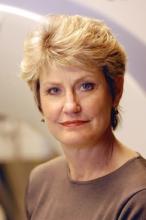SAN DIEGO – Although the release of the U.S. Preventive Services Task Force grade B recommendations on lung cancer screening in December 2013 marked an important advance in the field, they are not the last words on the issue.
"There are innumerable other questions for which we don’t have great answers," Dr. Denise R. Aberle said at the Joint Conference on the Molecular Origins of Lung Cancer sponsored by the American Association for Cancer Research and the International Association for the Study of Lung Cancer.
These include lack of data on the optimal screening population, interpretation algorithms, and cost effectiveness, said Dr. Aberle, professor of radiology and bioengineering at the University of California, Los Angeles. "Because there remain many unanswered questions, and the implementation process is not standardized, the single most important thing we can do in screening programs is to collect the data that would be necessary to inform these questions."
The primary difference between the recommendations of the U.S. Preventive Services Task Force and those of the National Lung Screening Trial (NLST) is the USPSTF’s expanded age range of 55-80 years. The USPSTF "also added the caveat that screenings should be discontinued once patients are beyond the age of 80, if there is a smoking cessation history of greater than 15 years, or in the face of significant comorbidity that would likely be a factor in competing mortality or would render that person unable to tolerate treatment," she said.
USPSTF investigators used data from the Cancer Intervention and Surveillance Modeling Network (CISNET) to inform their decision-making. CISNET consists of investigators from five different institutions who have each developed independent, natural histories of lung cancer in modeling exercises. They used each of their five models, and tested at least 500 different strategies for screening based on differences in the frequency of screening (anywhere from annually to once every 3 years), start and stop ages, pack-year intensity, and the number of years since quitting smoking. By doing so, the USPSTF investigators determined that mortality reduction with screening was 15%, estimated that 50% of cancers would be early stage, and projected that 497 per 100,000 lung cancer deaths would be averted.
"We now have guidelines that we can build on," Dr. Aberle said of the USPSTF recommendations.
She characterized false positivity rates as "probably the most significant downside of CT screening" for lung cancer. "It results in unnecessary follow-up imaging and excess radiation, [and] unnecessary biopsies and surgical procedures with their attendant complications, costs, and unnecessary anxiety," she said.
In a study of NLST participants led by Dr. Aberle, 24% of all screens were positive based on the observation of a nodule of 4 mm or larger (N. Engl. J. Med. 2011;365:395-409). "It turns out that about two-thirds of positive screens were for a nodule that was 7 mm or smaller in size," she said. "Finally, 96% of positive screens were not associated with a lung cancer diagnosis. How do we address this? The easiest way to look at this is to look at nodule size, which remains the most durable of imaging biomarkers that we have thus far."
About 7% of all lung cancers occurred in nodules between 4 and 6 mm in diameter, but Dr. Aberle and her associates noticed two inflection points. First, relative to nodules 4-6 mm in diameter, nodules in the 7- to 10-mm diameter range translate into about a threefold increase in the numbers of lung cancers observed. Second, nodules greater than 10 mm in diameter roughly translate into a doubling in the number of lung cancers observed. "After 20 mm, the numbers of cancers decrease, as do the number of nodules," she said.
In subsequent analyses, Dr. Aberle and her associates found that using a 7-mm nodule as the threshold size for screen positivity would result in a delay in diagnosis of perhaps 2% of lung cancers relative to first observation. "This is clearly an area that we’ll be looking at when we look toward screening implementation," she said.
With respect to diagnostic algorithms, a number of organizations are looking to standardize interpretations, including the American College of Radiology, which is developing a standardized reporting system called LUNG-RADS. In this algorithm, category 1 = negative, 2 = benign, 3 = likely benign (not actionable), 4 = suspicious, 5 = highly suspicious, and S = significant/other. In categories 1-3, annual screening would be recommended. "Level 4 screens would dictate an early follow-up, generally within 4-6 months of the baseline CT scan," Dr. Aberle explained. "Nodules that are highly suspicious typically undergo some form of additional tissue sampling."


